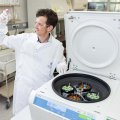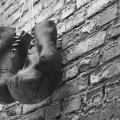The University of Queensland is rediscovering elements of a native rainforest at its 7.5 hectare Indooroopilly Experimental Mine site and staff are observing with delight the return of native fauna.
The University is into the second year of a seven-year landscape management plan for the site, which was originally a working silver/lead mine which the University acquired in 1967.
The Experimental Mine site houses the Julius Kruttschnitt Mineral Research Centre and its commercial offshoot JKTech. It is the only experimental mining site so close to a city University campus anywhere in the world.
Senior Supervisor of Grounds Shane Biddle said it was an exciting project with the University working in close conservation partnership with local environmental groups.
“Over the years a number of pest plant species have colonised the site, ranging from stands of Chinese elms and Camphor laurels to thick infestations of Asparagus fern, Cat’s claw creeper, Lantana and Duranta,” he said.
“The landscape management plan by Gregory Hicks and ecologist Dave Gasteen divides the site into 11 management areas, and we’re looking to reduce fire hazard risks, erosion and control weed populations, while identifying and encouraging native flora and fauna on site.
“The plan also proposes strategies to unify the site with regional fauna and flora corridors.
“We’ve learned a lot of lessons on site, all the while coping with drought conditions and learning to outwit the local Rusa deer population, who at one stage were stripping the bark off native trees and trampling vegetation.
"This problem was remedied by installing a temporary deer fence.”
The University is helping to maintain the plantings by installing 30,000 litres of rainwater tanks on site, with another 10,000 litre tank to be installed, and by extensive mulching of the gardens.
Specialist gardener Mr Phil MacDonald, who is a UQ Bachelor of Applied Science (Protected Area Management) graduate from UQ Gatton, said the University’s Experimental Mine site was a significant inner urban bushland site.
It provided a link between remnant vegetation on the Brisbane River and Mt Coot-tha forest.
“Revegetation and regeneration carried out so far will contribute to increasing the site’s potential as a fauna corridor. All the revegetation species are endemic, and should benefit local wildlife,” Mr MacDonald said.
“We’ve been excited to identify existing and regenerating rainforest species, such as Celerywood, Quandong, Axe-handle wood, Small leafed tuckeroos, Scrub turpentine and Red and Green kamalas.
“Seeds have been collected and propagated from a number of native species, including two varieties of Acacias. We’re planting species that will encourage fauna such as the Richmond’s Birdwing Butterfly.
“A recent spotlighting session by Dr Ian Gynther (Environmental Protection Agency) of fauna on site found a colony of Short-eared Brushtail Possums (Trichosurus caninus) - believed to be the closest colony to Brisbane city, which is very exciting.
“The site contains an amazing array of native wildlife for an inner urban area. Native wildlife observed by staff and students on site have also included Carpet snakes, Burton’s lizard snake, White-headed pigeons, Eastern Whipbirds, King Parrots, a Swamp wallaby, Tawny frogmouth owls, and Pheasant coucals.”
Mr MacDonald said further spotlighting observation and trapping would provide a greater picture of what was on site.
Mr Biddle said staff working at the Experimental Mine site had been very helpful in recording and monitoring of flora and fauna.
The University had also conducted a spotlighting session with an ecology PhD student Sarah Bell, conducted mine walks with members of the Cubberla Witton Catchment Network, and has installed glider nesting boxes.
A UQ environmental management student Jesse Owens will help with future fauna surveying and it is hoped that the University will participate in bat and dung beetle surveys in cooperation with the Cubberla Witton Catchment Network.
“We are working towards getting land for wildlife recognition for the site, and we’d like to thank all staff and students, and our conservation partners who have helped the University to date,” Mr Biddle said.
“We’ll be placing signage information for the community on site, and improving site accessibility with dedicated tracks and pathways.
“We would be very interested in hearing from any interested University staff, students, TAFE and conservation groups or members of the community who would like to assist us in the regeneration of this wonderful site.”
People who wish to assist can contact Mr Biddle at telephone 3365 2280.
Media: Jan King 0413 601 248.



